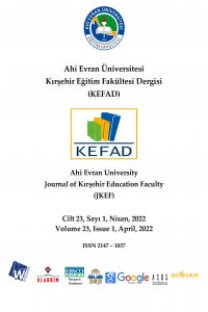Fen Bilgisi Derslerinde Benzeşimlerin (Analoji) Kullanılabilirliğine İlişkin Öğretmen Adaylarının Görüşleri ve Örnekleri
Preservice Science Teachers' Views on Usability of Analogies in Science Courses and Their Examples
___
- Bilaloğlu, R. G. (2006). Altı Yaş Çocuklarına Bağışıklık Sisteminin Analoji İle Öğretiminin Başarı ve Kalıcılığa Etkisi. Çukurova Üniversitesi Sosyal Bilimler Enstitüsü. Yayımlanmamış Yüksek Lisans Tezi. Adana
- Brown, D. E. & Clement, J. (1987). Overcoming Misconceptions in Mechanics: A Comparison of Two Example-Based Teaching Strategies. Paper Presented at the Annual Meeting of the American Educational Research Assocation, Washington, DC.
- Brown, D. E. & Clement, J. (1989). Overcoming Misconceptions via Analogical Reasoning: Abstract Transfer Versus Explanatory Model Construction. Instructional Science. 18, 237–261
- Clement, J. (1987). Overcoming Students’ Misconceptions in Physics: The Role of Anchoring Intuitions and Analogical Validity. In J. Novak (Ed.) Proceedings of The 2nd International Seminar Misconceptions and Educational Strategies in Science and Mathematics. Ithaca, NY: Cornell University Press, v.3, 84-97
- Clement, J. (1993). Using bridging analogies and anchoring intuitions to deal with students preconceptions in physics, Journal of Research in Science Teaching. 30 (10), 1241–1257.
- Çimen, S. (1999). Okulöncesi Eğitimde Analoji. Yayımlanmamış Seminer Raporu, A. Ü. Fen Bilimleri Enstitüsü, Ankara
- Dagher, Z. R. (1995). Review of studies on the effectiveness of instructional analogies in science education. Science Education, 79, 295–312.
- Dagher, Z. R. (1998). The Case for Analogies in Teaching Science for Understanding, in Mintzes, J. J., Wandersee, J. H, Novak J. D., (Eds.) Teaching Science for Understanding; A Constructivist View, Academic Pres.
- Driver, R. and Bell, B. (1986). Students’ Thinking and the Learning of Science: A Constructivist View. School Science Review, 67, 443 –456.
- Duit, R. (1991). On the Role of Analogies and Metaphors in Learning Science. Science Education. 75 (6), 649–672.
- Gentner, D. (1983). Structure-Mappind: A Theoretical Framework for Analogy. Cognitive Science, 7, 155–170.
- Gentner, D. & Holyoak, K. J. (1997). Reasoning and Learning by Analogy. American Psychologist. 52 (1), 32–34.
- Glynn, S. M. (1989). The Teaching with Analogies Model: Explaining Concepts in Expository Texts. In K. D. Muth (Ed.), Children’s Comprehension of Narrative and Expository Text: Research into Practice. Neward, DE: International Reading Association, 185–204.
- Glynn, S. M. (1991). Explaining Science Concepts: A Teaching-With-Analogies-Model. In S. Glynn, R. Yeany, & B. Britton (Eds.), The Psychology of Learning Science, Hillsdale, NJ: Erlbaum, 219–240.
- Glynn, S. M., Britton, B. K., Semrud, M. & Muth, K. D. (1989). Analogical Reasoning and Problem Solving in Science Textbooks, In J. A. Glover, R. R. Ronning, & C. R. Reynolds (Eds.), A Handbook of Creativity: Assessment, Research and Theory, New York: Plenum.
- Glynn, S. M. & Duit, R. (1995). Learning science meaningfully: Constructing conceptual models. In S.M. Glynn and R. Duit (Eds.), Learning science in the schools: Research reforming practice (pp. 3–33). Mahwah, NJ: Erlbaum
- Heywood, D. (2002). The Place of Analogies in Science Education, Campridge Journal of Education, 32 (2), 64-75.
- Karasar, N. (2001). Bilimsel Araştırma Yöntemi: Kavramlar, İlkeler, Teknikler. 11. Basım, Ankara, Nobel Yayınevi.
- Rumelhart, D. E. & Normann, D. A. (1981). Analogical Processes in Learning. In J. R. Anderson (Ed.), Cognitive Skills and Their Acquisition. Hillsdale, NJ: Erlbaum, 335–359.
- Senemoğlu, N. (2003). Gelişim Öğrenme ve Öğretim: Kuramdan Uygulamaya. Ankara: Gazi Kitabevi
- Spiro, R. J., Feltovich, P. J., Coulson, R. L. & Anderson, D. K. (1989). Multiple Analogies for Complex Concepts: Antidotes for Analogy-Induced Misconception in Advanced Knowledge Acquisition. In S. Vosniadou & A. Ortoni (Eds.). Similarity and Analogical Reasoning. Cambridge: Campridge University Pres, 498–531.
- Wong, E. D. (1993). Understanding the Generative Capacity of Analogies as a Tool for Explanation. Journal of Research in Science Teaching, 30 (10) 1259–1272.
- Zeitoun, H. H. (1984). Teaching Scientific Analogies: A Proposed Model. Research in Science and Technology Education, 2, 107–125.
- ISSN: 2147-1037
- Yayın Aralığı: 3
- Başlangıç: 2000
- Yayıncı: Ahi Evran Üniversitesi Kırşehir Eğitim Fakültesi
Günlük Yaşamdaki Olayların Fen Bilimleri Öğretiminde Kullanılması
Kamuran TARIM, Ayten İFLAZOĞLU, Dilek IŞIK
DENEY YÖNTEMİ VE COĞRAFYA ÖĞRETİMİNDE KULLANILMASI
Sınıf Öğretmeni Adaylarının İnternet Kullanımına İlişkin Tutumlarının Değerlendirilmesi
Kasım YILDIRIM, Aykut Emre BOZDOĞAN, Ertuğrul USTA
Üniversite Öğrencilerinin Epistemolojik İnançları ile Problem Çözme Becerileri Arasındaki İlişkiler
